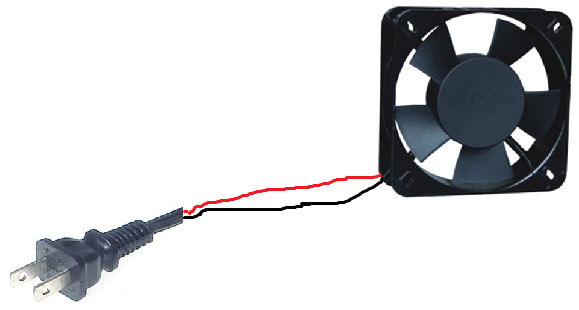How to Build a Simple AC Fan Circuit

In this project, we will demonstrate how to build a simple AC Fan circuit.
An AC fan is a fan which is run by AC power.
When sufficient AC voltage is fed into the terminals of the fan, the fan spins.
Disclaimer- AC voltage from a wall outlet can be very dangerous. The voltage is very high in magnitude and can cause serious injury or even death. For this reason, we recommend that you do not do this project unless you have a professional working with you or you have adequate experience working with AC power. If you do not, just read this project to find out how this fan would work, but don't attempt it. Don't risk the chance of being injured by dangerous AC wall outlet power.
For a more safe project, check out How to Build a DC Fan Circuit. DC is much
safer than AC voltage than a wall outlet. And both fans carry out pretty much identical functions. In both, the blades spin alike, just on different types of power. AC runs on AC voltage. DC
runs on DC voltage.
To power an AC fan, we feed the fan its rated voltage.
For example, to power a 120Vac fan, we need to feed it 120 volts AC.
This is about the same power which comes out of a standard wall outlet in the United States.
So all we would need to do is take a plug, such as the one seen below:

And solder it directly to the terminal wires of the fan. The positive terminal wire of the fan must match up with the positive terminal wire of the plug. And the negative terminal wire of the fan must match up with the negative terminal wire of the plug. Polarity must be consistent between the two.
Once this is in place, this is all that is needed for the fan to work.
All the fan needs is the AC voltage provided from the wall outlet. With this power, it can run.
Below is the complete circuit with plug and fan together:

This is the most basic AC fan circuit that can be produced.
We can do a number of modifications to give this fan more features, such as add a potentiometer to the circuit. With a variable resistor, we can vary the resistance of the circuit. This, in turn, varies the voltage which is fed to the AC fan. With more voltage, the AC fan runs quicker, because it's fed more power. With lower voltage, the AC fan speed runs slower, because it's fed less power. This is a common feature on most fans- the ability to vary the speed by changing the resistance of the circuit.
We can also add a simple SPST switch, so that we can turn the power to the fan on or off.
Basically, we can add a lot of features to this, but this project shows the simplicity of a simsple AC fan circuit.